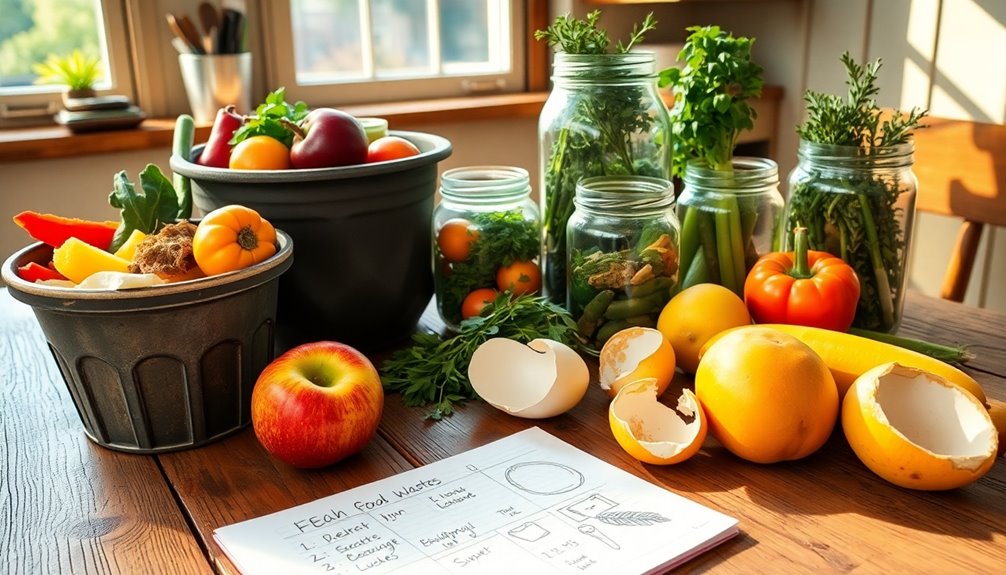Reducing food waste at home is easier than you think! Start by planning your meals wisely and sticking to a grocery list to avoid impulse buys. Store your food properly in clear, airtight containers and label leftovers with dates. Understand expiration dates and trust your senses for freshness. Get creative with leftovers to make new dishes. Don't forget to compost food scraps to nourish your garden. Buy in bulk smartly but only if you'll use everything, and consider sharing surplus food with neighbors or local food banks. You'll discover even more valuable tips to further your sustainability efforts.
Key Takeaways
- Create a meal plan and grocery list to avoid impulse buys and ensure you only purchase what you need.
- Store leftovers in clear, airtight containers and label them with dates to promote proper consumption and reduce spoilage.
- Practice portion control and repurpose leftovers into new dishes to minimize waste from uneaten food.
- Compost food scraps to enrich your garden soil, reducing waste and contributing to a sustainable environment.
- Donate surplus food to community fridges or participate in food-sharing programs to help those in need while minimizing waste.
Plan Your Meals Wisely
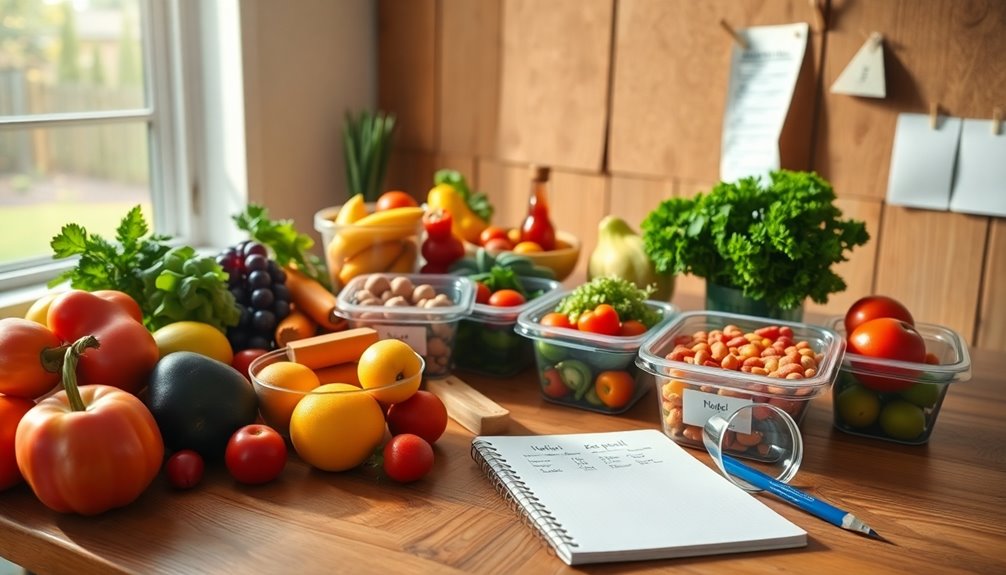
Planning your meals wisely can greatly diminish food waste at home. It's all about being intentional with what you buy and how you prepare food. Start by creating a grocery list before heading to the store. This simple step can help you focus on what you really need, reducing the temptation to buy items you won't use.
Think about the meals you want to enjoy throughout the week, and jot down the ingredients required.
When you're at the store, stick to your list. This can help you avoid impulse purchases that often lead to wasted food. Another key aspect is portion control. By estimating the right amount of food for your meals, you'll avoid cooking more than necessary. If you know that a recipe serves four, but you're only feeding two, adjust the ingredients accordingly.
On days when you're feeling adventurous, consider using leftovers creatively in your meals. You can transform yesterday's dinner into a delicious soup or a hearty stir-fry. Not only does this help you use what you have, but it also inspires you to try new flavors. Additionally, sharpening your kitchen knives regularly can enhance your meal preparation efficiency, leading to greater precision in cutting.
Lastly, don't forget about the importance of meal planning. Setting aside a little time each week to decide what you'll cook can make a world of difference. You'll find yourself eating healthier, enjoying your meals more, and significantly reducing food waste. By following these tips, you'll be well on your way to creating a more sustainable kitchen and fostering a sense of belonging with your family and friends.
Store Food Properly
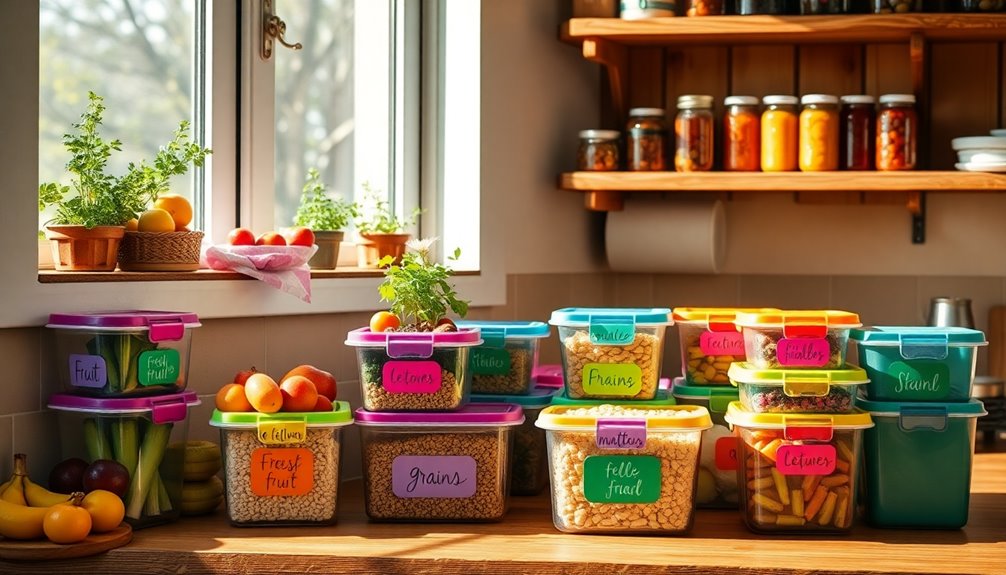
Storing food properly is essential if you want to maximize freshness and minimize waste. One of the first steps is to focus on container organization. Invest in clear, airtight containers that not only keep your food fresh but also allow you to see what you have at a glance. This simple change helps you avoid buying duplicates and forgetting about items hidden at the back of your pantry or fridge.
Next, consider various preservation methods to extend the life of your food. For example, refrigerate fruits and vegetables that benefit from cooler temperatures, like berries and leafy greens. Keep items like potatoes and onions in a cool, dark place to prevent sprouting.
You can also freeze leftovers or surplus ingredients; just make sure to label them with dates to track freshness. Additionally, incorporating more fresh fruits and green smoothies into your meals can be a great way to utilize perishable items before they spoil, as they provide rapid body fat elimination while ensuring you consume nutrient-rich ingredients.
Another tip is to store herbs in water or wrap them in a damp paper towel before placing them in a container. This keeps them vibrant and flavorful for longer.
When it comes to grains and dry goods, consider using vacuum-sealed bags or jars to protect them from moisture and pests.
Understand Expiration Dates
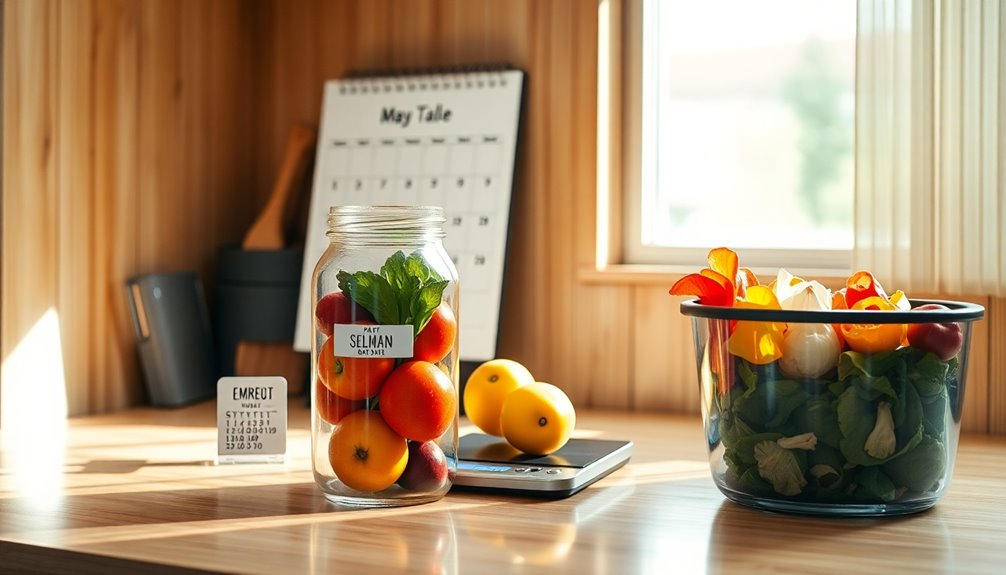
A clear understanding of expiration dates can significantly decrease food waste in your home. Many people assume that a date on a label means food is no longer safe to eat, but that's not always accurate. There are different types of dates: "sell by," "use by," and "best by." Knowing the difference can help you make more informed decisions about what to keep and what to toss.
Begin with label organization. Maintaining the orderliness of your pantry, fridge, and freezer is crucial. Group similar items together and place those nearing expiration at the front. This way, you'll see what needs to be used first, making it simpler to incorporate them into your meals. Remember, a little planning goes a long way.
Next, practice storage rotation. When you purchase new groceries, always shift older items to the front. This guarantees that you're utilizing what you already have before it spoils. It's a straightforward habit that can save you money and prevent waste.
When you're uncertain about a product's freshness, rely on your senses. If it looks, smells, and tastes fine, it's likely still good. Don't let a date dictate your food choices. Additionally, understanding the impact of traditional bread consumption on health can further inform your decisions on what to keep, especially if you're looking to reduce waste while maintaining a healthy diet. By understanding expiration dates and implementing efficient label organization and storage rotation, you'll not only reduce waste but also nurture a healthier relationship with your food. Your efforts will contribute to a more sustainable kitchen, and that's something to take pride in.
Utilize Leftovers Creatively
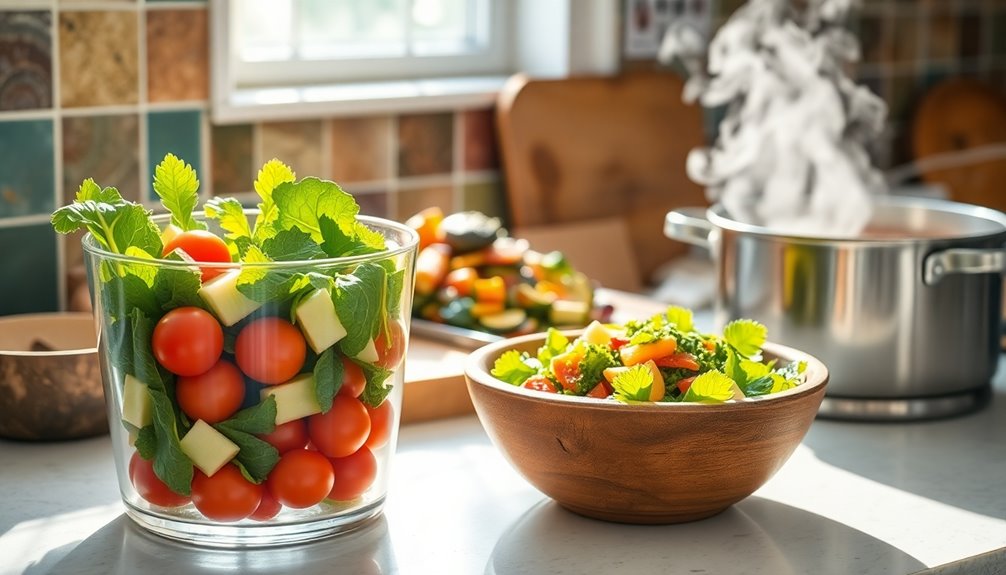
Leftovers can be a treasure trove of culinary possibilities waiting to be explored. Instead of letting them languish in the fridge, why not transform them into something exciting? By utilizing creative recipes, you can not only make your meals more enjoyable but also reduce food waste significantly. Meal planning plays a key role here; by thinking ahead, you can incorporate your leftover ingredients into your next dishes.
Here's a handy table to inspire your culinary creativity:
| Leftover Ingredient | Creative Recipe Idea |
|---|---|
| Cooked Chicken | Chicken Quesadillas |
| Roasted Vegetables | Vegetable Stir-Fry |
| Rice | Fried Rice with Veggies |
| Mashed Potatoes | Potato Pancakes |
You can mix and match ingredients based on what you have at home. For example, use your cooked chicken in a flavorful quesadilla, or combine roasted vegetables into a vibrant stir-fry. The key is to think outside the box and be inventive!
When you plan your meals, consider how you can repurpose leftovers. Not only will it save you time and money, but it'll also bring a new spark to your meals. Plus, sharing your creative recipes with friends and family can foster a sense of community and belonging. Additionally, an unhealthy liver can lead to increased fatigue and other health complications, making it even more important to utilize every ingredient you have on hand. So, embrace those leftovers and turn them into delightful new dishes!
Compost Food Scraps
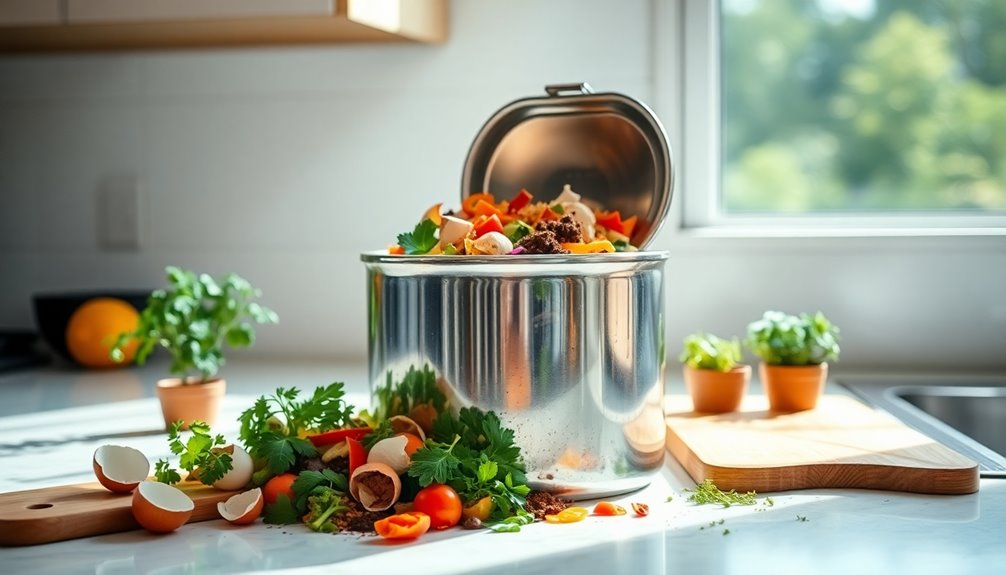
Composting food scraps is a fantastic way to reduce waste while nourishing your garden. By turning kitchen scraps into compost, you're not only minimizing what goes to the landfill, but you're also creating a rich, organic material that can help your plants thrive.
The benefits of composting are numerous. It improves soil health, helps retain moisture, and reduces the need for chemical fertilizers. Plus, it's a great way to contribute positively to your community by reducing overall waste.
When starting your composting journey, consider the various compost bin options available. You can choose from a traditional bin, a tumbling composter, or even a worm bin, depending on your space and needs.
If you have a small yard or live in an apartment, a worm bin might be the perfect solution. These compact systems can fit in tight spaces and turn your food scraps into nutrient-rich compost with the help of hungry little red wigglers!
To get started, simply collect your kitchen scraps—like fruit and vegetable peels, coffee grounds, and eggshells—and add them to your chosen bin. Be sure to balance "green" materials (like fruit scraps) with "brown" materials (like dried leaves or cardboard). This balance is key to maintaining an efficient composting process. Additionally, adopting natural calorie cycles can help you become more mindful of food consumption and waste reduction.
Buy in Bulk Smartly
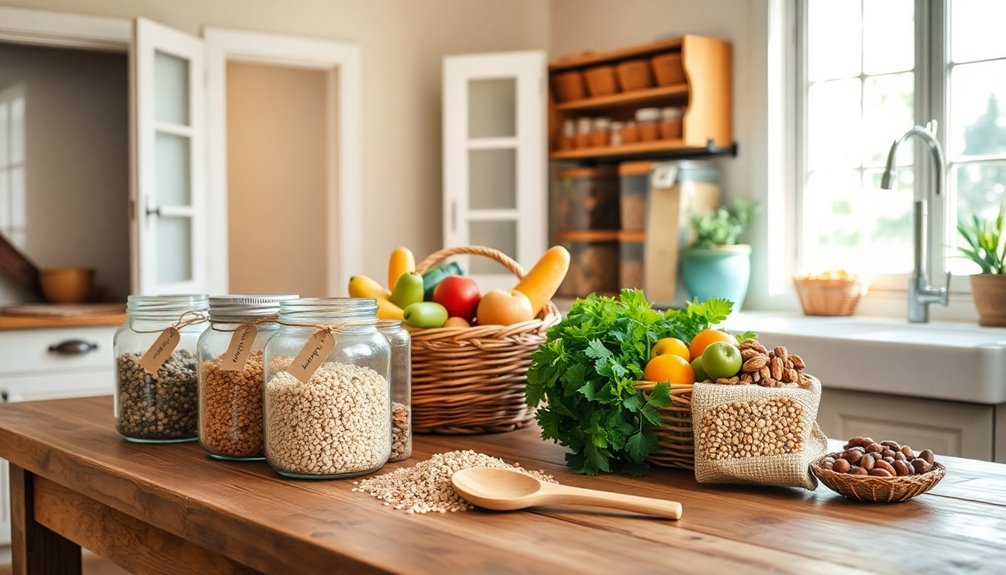
When it comes to reducing food waste, buying in bulk can be a game changer. It helps you save money, but it also encourages mindful consumption. However, to truly make the most of bulk purchases, you need to be strategic about it. Here are some tips to help you buy in bulk cleverly:
- Know Your Needs: Before you head to the store, assess what you actually consume regularly. Focus on staple items that you use in your meal prep, like grains, beans, or spices. This way, you won't end up with excess.
- Practice Portion Control: Bulk buying can lead to larger quantities, which might be overwhelming. Divide the items into smaller portions right after purchase. This approach not only helps with managing your intake but also makes it easier to incorporate into your meal prep.
- Store Properly: Invest in airtight containers to keep bulk items fresh longer. Proper storage can significantly extend the shelf life of your purchases, reducing the chance of spoilage.
- Plan Your Meals: Meal prep is essential when you buy in bulk. Create a meal plan using those bulk items, ensuring you use them before they go bad. This not only minimizes waste but also streamlines your cooking process.
Additionally, remember that proper meal planning can help you align your purchases with your dietary goals, such as following a custom keto diet, which may also help in reducing food waste by ensuring you use all ingredients efficiently.
Share Surplus Food
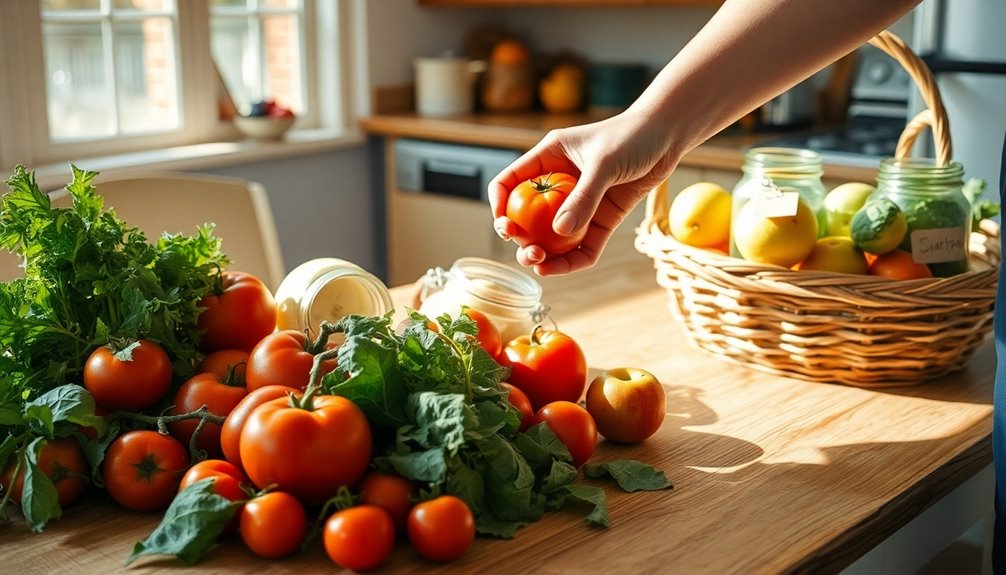
Sharing surplus food is an effective way to combat waste while fostering community connections. When you have extra food that you can't use, consider donating it to food sharing programs or community fridges. These initiatives not only help reduce waste but also create a sense of belonging and support among neighbors. Additionally, sharing food can contribute to overall health and well-being, as it promotes increased oxygen intake among community members who may benefit from nutritious meals.
Here's how sharing can make a difference:
| Action | Impact on Community | Feelings Evoked |
|---|---|---|
| Donate to a Community Fridge | Provides access to food for those in need | Connection, empathy |
| Participate in Food Sharing Programs | Reduces waste and feeds local families | Generosity, fulfillment |
| Organize a Neighborhood Swap | Encourages sharing and reduces excess | Trust, camaraderie |
| Host a Potluck | Strengthens relationships through shared meals | Joy, inclusion
Frequently Asked Questions
How Can I Track My Food Inventory at Home?
To track your food inventory at home, start by organizing your items clearly. Group similar foods together and label containers for easy access. Consider using digital tracking apps that let you log what you have, making updates simple as you use or buy items.
This way, you'll always know what's in your pantry and fridge, helping you plan meals better and reduce waste. Plus, it feels great to be organized and efficient!
What Are the Best Containers for Food Storage?
Ever wondered how to keep your leftovers fresh and inviting? Glass containers with airtight lids are your best bet! They not only preserve flavors and textures but also add a touch of elegance to your kitchen. Plus, you won't have to worry about harmful chemicals leaching into your food.
How Do I Know if Food Is Still Safe to Eat?
To know if food's still safe to eat, check the expiration dates and follow storage guidelines. If a product's past its expiration date, it's best to toss it. Look for signs like off smells, discoloration, or mold.
When in doubt, trust your instincts—if it seems questionable, don't risk it. Remember, keeping your food fresh not only helps your health but also fosters a sense of belonging by sharing safe meals with others.
What Are Creative Ways to Use Vegetable Scraps?
Scrappy solutions spark sustainability! You can transform vegetable scraps into delightful dishes. Start composting projects to enrich your garden, turning leftovers into luscious soil.
Or, whip up homemade broths by simmering those scraps with herbs and spices for a flavorful base. Experiment with veggie peel chips or stir-fry remnants, too!
These creative uses not only reduce waste but also connect you with culinary communities, making your kitchen a hub of innovation and belonging.
How Can I Encourage My Family to Reduce Food Waste?
To encourage your family to reduce food waste, start by setting examples with your own habits. Involve everyone in meal planning, making it a fun activity where everyone can suggest dishes. Use communication strategies like family meetings to discuss waste and share tips. Celebrate small victories together, emphasizing how each effort counts. By fostering a sense of teamwork, you'll create an environment where reducing waste becomes a shared goal, strengthening your family's bond.
Conclusion
By implementing these tips, you can tackle food waste and make a positive impact on your household and the environment. Remember, every little bit helps—don't let the small stuff slip through the cracks! With thoughtful planning, proper storage, and creative use of leftovers, you'll find it easier to reduce waste and save money. So, take these simple steps to heart, and watch how your efforts can lead to a greener, more sustainable kitchen!

